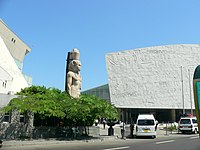Bibliotheca Alexandrina
From Wikipedia, the free encyclopedia
The Bibliotheca Alexandrina (Latin for "Library of Alexandria"; in Arabic: مكتبة الإسكندرية ) is a major library and cultural center located on the shore of the Mediterranean Sea in the Egyptian city of Alexandria. It is both a commemoration of the Library of Alexandria that was lost in antiquity and an attempt to rekindle something of the brilliance that this earlier center of study and erudition represented.
Contents |
[edit] History
The idea of reviving the old library dates back to 1974, when a committee set up by Alexandria University selected a plot of land for its new library, between the campus and the seafront, close to where the ancient library once stood. The notion of recreating the ancient library was soon enthusiastically adopted by other individuals and agencies. One leading supporter of the project was current Egyptian President Hosni Mubarak; UNESCO was also quick to embrace the concept of endowing the Mediterranean region with a center of cultural and scientific excellence. An architectural design competition, organized by UNESCO in 1988 to choose a design worthy of the site and its heritage, was won by Snøhetta, a Norwegian architectural office, from among more than 1,400 entries. At a conference held in 1990 in Aswan, the first pledges of funding for the project were made: USD $65 million, mostly from the Arab states. Construction work began in 1995 and, after some USD $220 million had been spent, the complex was officially inaugurated on October 16, 2002.[1]
[edit] Building and Library Features
The dimensions of the project are vast: the library has shelf space for eight million books, with the main reading room covering 70,000 m² on eleven cascading levels. The complex also houses a conference center; specialized libraries for the blind, for young people, and for children; three museums; four art galleries; a planetarium; and a manuscript restoration laboratory. The library's architecture is equally striking. The main reading room stands beneath a 32-meter-high glass-panelled roof, tilted out toward the sea like a sundial, and measuring some 160 m in diameter. The walls are of gray Aswan granite, carved with characters from 120 different human scripts.
The collections at the Bibliotheca Alexandria were donated from all over the world. The Spanish donated documents that detailed the ruling of the Moors. The French also donated, giving the library documents dealing with the building of the Suez Canal.
Bibliotheca Alexandrina maintains the only copy and external backup of the Internet Archive.
[edit] Management
The current director is Ismail Serageldin. He also chairs the Boards of Directors for each of the BA's affiliated research institutes and museums and is a professor at Wageningen University in the Netherlands.
[edit] Criticism
The dream of restoring Alexandria to its academic roots has not gone without some outcries from the public. Some experts question whether modern day Egypt can afford to supply such a library with all the materials it needs, or if the government can truly keep censorship out of the collection.[2] In addition, the building's elaborate architecture (which imitates a rising Sun) upset some who believed too much money was being spent on construction rather than the library's actual collection. Due to the lack of available funds, the library had only 500,000 books in 2002, low compared to other national libraries. It has been estimated that it will take 80 years to fill the library to capacity at the current level of funding. The library relies heavily on donations to buy books for its collections.[3] Other complaints have arisen, including controversy over better use of funds for more urgent social projects. For example, Egypt has an illiteracy problem, with only 59% of females and 83% of males able to read.[4][5]
[edit] See also
[edit] References
- Watson, Bruce (April 2002). "Rising Sun". Smithsonian Magazine. http://www.smithsonianmag.com/travel/rising.html. Retrieved on 2009-02-24.
- ^ http://www.islamonline.net/servlet/Satellite?pagename=Zone-English-ArtCulture/ACEZoneBibliotheca Alexandrina
- ^ Bilboul, Roger (December 2002), "The Library of Alexandria Reopens", Information Today 19 (11): 26, http://www.infotoday.com/it/dec02/bilboul.htm
- ^ Watson, Bruce (April 2002), "Rising Sun", Smithsonian 2002 (April), http://www.smithsonianmagazine.com/issues/2002/april/rising.php
- ^ CIA World Fact Book - "Egypt". September 20 2007. Accessed October 4 2007.
- ^ Arseneault, Michel (April 1999), "Alexandria, from papyrus to the Internet", The UNESCO Courier 52 (4): 41-42, http://www.unesco.org/courier/1999_04/uk/signes/intro.htm
[edit] External Links
| Wikimedia Commons has media related to: Bibliotheca Alexandrina |
- Bibliotheca Alexandrina official website
- Bibliotheca Alexandrina Webcast
- Bibliotheca Alexandrina webarchive
- Portfolio of photographs of the complex
- Full Photo Collection of the Walls of Bibliotheca Alexandrina
- Bibliotheca Alexandrina: An Ancient Library Goes Modern - illustrated article
- Bibliotheca Alexandrina video
- Wikimania 2008 venue description
- Friends of the Bibliotheca Alexandrina Mexico Association (official Mexican site)




